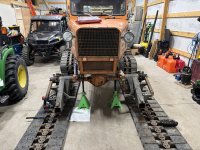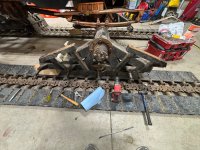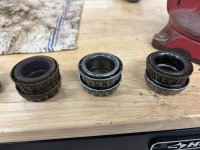Hello all from a newbie and would like to start out by thanking all of you for all of the posts and wonderful information and pictures on this forum, it has helped me a ton to date. The 1442 that I purchased came out of the Northeast and even though it was fairly well maintained they did miss quite a few areas. I plan on doing a full restoration on it (basically replace every nut and bolt) and bring it back to like new condition. I currently have the front tracks off if it as it needed new sprockets and a few of the idler wheels need new bearings. I know I read in one of the posts but have been unable to find it again how you all have removed stuck spindles. Most all of the wear parts on the carriers are super rusted and I have had to "massage" a few pieces out, but the spindles are in the same condition, and I cannot get them out and do not want to tear them up as they appear to be in good shape. Any ideas would be greatly appreciated. And I plan on posting some picture here soon. Thanks in advance.
-
Please be sure to read the rules and adhere to them. Some banned members have complained that they are not spammers. But they spammed us. Some even tried to redirect our members to other forums. Duh. Be smart. Read the rules and adhere to them and we will all get along just fine. Cheers. :beer: Link to the rules: https://www.forumsforums.com/threads/forum-rules-info.2974/
You are using an out of date browser. It may not display this or other websites correctly.
You should upgrade or use an alternative browser.
You should upgrade or use an alternative browser.
Stuck Bogie/Idler Wheel spindles on 1977 Tucker 1442
- Thread starter WyoSnow
- Start date
https://www.forumsforums.com/threads/sno-w-cat-serenade-march-13-16-2020.84108/post-20719002
https://www.forumsforums.com/threads/sno-w-cat-serenade-march-13-16-2020.84108/post-20719051
I'm sure BFT will be here soon to expand on all of the details, but from everything that has been posted about them, that is the most miserable part about owning a rubber tracker.
https://www.forumsforums.com/threads/sno-w-cat-serenade-march-13-16-2020.84108/post-20719051
I'm sure BFT will be here soon to expand on all of the details, but from everything that has been posted about them, that is the most miserable part about owning a rubber tracker.
Thank you Davenet, I knew it was not going to be easy but starting with the tensioner spindles first and going to try and press them out. I had to drill out the bolts that hold the UHMW on and not a terrible job just time consuming but learning real quickly that nothing goes fast on these cats and when you have them apart address anything you find and that time as it will only get worse if prolonged. Not sure why the old mechanics never used anti seize on any of the parts? I work in the oil and gas industry and we put it on everything as it just makes life that much easier at the end of the day.
On another note here are some of the idler wheel bearings that I pulled out, I read a really good discussion on that the other day and which brand to use and were the cheaper ones better? From the ones that I pulled out the Timken bearing held up better than the others, I have no idea what brand the other were as there are no markings on them but what I did find that even when the seals were out the Timken did not rust and fall apart like the others they seem to be just a little heavier built and better materials from what I assessed. Another question is on the outside of the idler some of my wheels just had washers and others had caps (about a 50/50 mix of them) the washers are obviously easier to remove but the caps seem to hold the grease better? They put silicone on the caps to help them seal up but not sure if Loctite would be better? The caps were not bad to remove but was wonder if the washers were better as I seee most of you guys are just running washers? I also notice that the seals that were installed backwards did hold up better (were still in place and holding) but only had 1 or 2 that were that way most were installed correctly and most were either leaking or completely gone. Just an FYI from what I have found.
On another note here are some of the idler wheel bearings that I pulled out, I read a really good discussion on that the other day and which brand to use and were the cheaper ones better? From the ones that I pulled out the Timken bearing held up better than the others, I have no idea what brand the other were as there are no markings on them but what I did find that even when the seals were out the Timken did not rust and fall apart like the others they seem to be just a little heavier built and better materials from what I assessed. Another question is on the outside of the idler some of my wheels just had washers and others had caps (about a 50/50 mix of them) the washers are obviously easier to remove but the caps seem to hold the grease better? They put silicone on the caps to help them seal up but not sure if Loctite would be better? The caps were not bad to remove but was wonder if the washers were better as I seee most of you guys are just running washers? I also notice that the seals that were installed backwards did hold up better (were still in place and holding) but only had 1 or 2 that were that way most were installed correctly and most were either leaking or completely gone. Just an FYI from what I have found.
Attachments
Track Addict
Bronze Member
If you have round press caps most likely you have the newer axles which is best.
First axles had just steel spacers front and back no washers no caps, nut, cotter. Spacer sat inside the seal and allowed nut to tension the taper bearings. Water ingress was an issue.
Next evolution was to machine a groove into the spacer and add an oring for water ingress.
Washers came along because cold greasing blew the seals out. Then legend says that Cooks Equipment in VT started installing the seals backward to allow old grease to exit and water to not enter better. Possibly need for less grease could be true as well not filling the seal.
The cap axle is the newest. No spacers, axle has a machined spacer like a modern trailer hub the seal rides on. Front bearing also like a trailer with a watertight cap. Much less water ingress, less parts, and cheaper to build.
Lubriplate low temp grease regularly for the win! Don’t think bearing manufacture matters much these days with consolidation and private labeling. Might have to hone bearings to fit the tolerances can be that off on both sides. Nothing precision here.
Keep the water out and grease often for longevity.
My 1443 thread outlines much of this. Swapped an axle but it was smooth. Think someone used a hilti or small jack hammer to drive out with some heat.
Sandblast where the UHMW track slides are welded to the frame and all the weld areas. Most likely there is cracking under the paint and filth.
First axles had just steel spacers front and back no washers no caps, nut, cotter. Spacer sat inside the seal and allowed nut to tension the taper bearings. Water ingress was an issue.
Next evolution was to machine a groove into the spacer and add an oring for water ingress.
Washers came along because cold greasing blew the seals out. Then legend says that Cooks Equipment in VT started installing the seals backward to allow old grease to exit and water to not enter better. Possibly need for less grease could be true as well not filling the seal.
The cap axle is the newest. No spacers, axle has a machined spacer like a modern trailer hub the seal rides on. Front bearing also like a trailer with a watertight cap. Much less water ingress, less parts, and cheaper to build.
Lubriplate low temp grease regularly for the win! Don’t think bearing manufacture matters much these days with consolidation and private labeling. Might have to hone bearings to fit the tolerances can be that off on both sides. Nothing precision here.
Keep the water out and grease often for longevity.
My 1443 thread outlines much of this. Swapped an axle but it was smooth. Think someone used a hilti or small jack hammer to drive out with some heat.
Sandblast where the UHMW track slides are welded to the frame and all the weld areas. Most likely there is cracking under the paint and filth.
TA thank you for all of the information much obliged.
As far as the Lubriplate there are 3 that I found with low temperature ratings (-50) which would you recommend:
SYN 1601- Lithium complex grease
SYN1602 - Lithium complex grease
SYN LTR-2/460 - Synthetic, Heavy-Duty, Tacky, Red Lithium Complex Grease
I may have missed one in there with low temperature ratings but not sure which one is better?
As far as the Lubriplate there are 3 that I found with low temperature ratings (-50) which would you recommend:
SYN 1601- Lithium complex grease
SYN1602 - Lithium complex grease
SYN LTR-2/460 - Synthetic, Heavy-Duty, Tacky, Red Lithium Complex Grease
I may have missed one in there with low temperature ratings but not sure which one is better?
Track Addict
Bronze Member
OG’s use Lubriplate Low Temp. Seeing was believing for me after use.
Low temp only application. Trailer axles on the highway different story.
Low temp only application. Trailer axles on the highway different story.
"I have no idea what brand the other were as there are no markings on them but what I did find that even when the seals were out the Timken did not rust and fall apart like the others they seem to be just a little heavier built and better materials from what I assessed."
The other brand: itchycrotchy, my bane of rebuilding equipment for many years.
The other brand: itchycrotchy, my bane of rebuilding equipment for many years.
Stuck spindles are not fun....
On our Thundercat and CHUGSzilla projects we removed all the spindles from the carriers. This was suggested by Tucker’s former parts and service manager Jeff Godard. Really, it’s preventive maintenance in case you ever have to change out a spindle in the field. Lying on your side, hopefully on a tarp and trying to swing a good sized hammer to beat the spindle out is a scenario I hope to never experience.
We did it in the comfort of Scott’s shop with a crane, a massive steel work table, oxyacetylene at the ready for heat, and a big hydraulic press. Even with all that... some of the spindles were downright recalcitrant. We eventually got them all out, and when it came time to reinstall them, they were liberally coated with anti-seize.
There is no magic bullet to get them out. In some cases (very few) it was just a few blows with about a three pound double jack. Others required the hydraulic press, some required heat, and still others required The Gorilla wailing away with a 12 pound sledge hammer. In the last situation you almost felt sorry for the spindle, the key word being “almost”.
I typically buy seals from Tucker, they used to be pretty reasonable cost-wise, but that was some time ago. They are a triple lip design and Tucker sources them from a company called Colonial Seal. If you elect to buy bearings and races from Tucker, you should know ahead of time they are made in China, and they aren’t Timken, Koyo, SKF or any other high quality bearing manufacturer. But think about it:
On your machine you have a total of 20 idler wheels and 40 tapered roller bearings. To make the math simple, let's say your Tucker weighed 8,000 pounds. That would be a load of only 200 pounds per bearing. And it’s not like Tuckers are fast, so the bearings don’t really spin very fast, either. In short, the task the bearings are required to fulfill is pretty minimal. The bearing size is very commonly used on boat trailers and you can find them quite cheaply.
It looks from the pics like your machine has an earlier design of grousers and perhaps the carriers as well. If the machine has a lot of hours on it, your journals may be worn. If so, I would encourage you to use what’s called bearing tape to essentially shim the journals to get them in alignment from the wear.
I think Track Addict was the first to do this, and we followed his lead with some work we did on a Tucker we re-cabbed known as the Vail Cat. They had broken the rear axle housing and we repaired that and did some other work. Here’s a link to that thread. You’ll have to scroll down a bit to get to the bearing tape posts.
On our Thundercat and CHUGSzilla projects we removed all the spindles from the carriers. This was suggested by Tucker’s former parts and service manager Jeff Godard. Really, it’s preventive maintenance in case you ever have to change out a spindle in the field. Lying on your side, hopefully on a tarp and trying to swing a good sized hammer to beat the spindle out is a scenario I hope to never experience.
We did it in the comfort of Scott’s shop with a crane, a massive steel work table, oxyacetylene at the ready for heat, and a big hydraulic press. Even with all that... some of the spindles were downright recalcitrant. We eventually got them all out, and when it came time to reinstall them, they were liberally coated with anti-seize.
There is no magic bullet to get them out. In some cases (very few) it was just a few blows with about a three pound double jack. Others required the hydraulic press, some required heat, and still others required The Gorilla wailing away with a 12 pound sledge hammer. In the last situation you almost felt sorry for the spindle, the key word being “almost”.
I typically buy seals from Tucker, they used to be pretty reasonable cost-wise, but that was some time ago. They are a triple lip design and Tucker sources them from a company called Colonial Seal. If you elect to buy bearings and races from Tucker, you should know ahead of time they are made in China, and they aren’t Timken, Koyo, SKF or any other high quality bearing manufacturer. But think about it:
On your machine you have a total of 20 idler wheels and 40 tapered roller bearings. To make the math simple, let's say your Tucker weighed 8,000 pounds. That would be a load of only 200 pounds per bearing. And it’s not like Tuckers are fast, so the bearings don’t really spin very fast, either. In short, the task the bearings are required to fulfill is pretty minimal. The bearing size is very commonly used on boat trailers and you can find them quite cheaply.
It looks from the pics like your machine has an earlier design of grousers and perhaps the carriers as well. If the machine has a lot of hours on it, your journals may be worn. If so, I would encourage you to use what’s called bearing tape to essentially shim the journals to get them in alignment from the wear.
I think Track Addict was the first to do this, and we followed his lead with some work we did on a Tucker we re-cabbed known as the Vail Cat. They had broken the rear axle housing and we repaired that and did some other work. Here’s a link to that thread. You’ll have to scroll down a bit to get to the bearing tape posts.
Some months ago a new forum member started a thread inquiring about purchasing a used axle assembly for a Tucker with a broken axle housing. Reading the thread and looking at the photos revealed this was the machine Scott and I had re-cabbed and sold several years ago. Here's that machine.
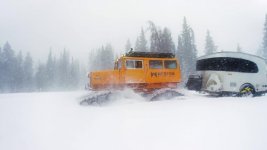
In addition to the cab modifications, we did a bunch of work to it - basically repairing anything and everything we found wrong. After talking with Scott, I made the offer that if you bring us the machine...

In addition to the cab modifications, we did a bunch of work to it - basically repairing anything and everything we found wrong. After talking with Scott, I made the offer that if you bring us the machine...
- Blackfoot Tucker
- Replies: 24
- Forum: Snowcat Repairs, Parts & Problems Forum
BFT thank you for the advice and not looking forward to the process but going to remove them all as you said as preventative maintenance. I do have mixes spindles on my machine and going to replace the older ones with the new ones (less parts to deal with). I did order some seals but will keep them from spares but will order new seals from Tucker, even though more expensive the triple lip design sounds much better. Most all of my bearings were in descent condition except for 3 of them and looks like they were just not able to get grease into the bearings so those were pretty nasty and dry, only had one that was completely shot but does not look like it did any damage but need to do some measuring to be sure. It seems like the old spindles has the bigger issues and the ones without caps definitely had issues with less grease and watered down grease, not sure if it is worth going all caps or not? Curious about your recommendation?
As far as the journals, it does look like the driver's side front has some wear as it is slightly tipped in but plan on pulling and having a good look later this summer, have read some of the posts on the bearing tape and looks like a good process and sounds like a good fix. I had a directive over the weekend that the shop needed to be cleaned for sons' graduation party so at this point just trying to get everything put back together to the out of the shop and then let the cleaning begin and hopefully get out for a late spring run to see everything that I am dealing with! I am having new hubs made as 2 of mine were pretty chewed up from lack of previous maintenance and the UHMW either worn down or being completely gone, I will repair the old ones and use for spares. I am also having the machine shop drill for all 14 bolts instead of just running the 7 as it just seems better (from another post I read I believe yours).
Again thank you for all of the advice and absolutely love reading all of the posts.
As far as the journals, it does look like the driver's side front has some wear as it is slightly tipped in but plan on pulling and having a good look later this summer, have read some of the posts on the bearing tape and looks like a good process and sounds like a good fix. I had a directive over the weekend that the shop needed to be cleaned for sons' graduation party so at this point just trying to get everything put back together to the out of the shop and then let the cleaning begin and hopefully get out for a late spring run to see everything that I am dealing with! I am having new hubs made as 2 of mine were pretty chewed up from lack of previous maintenance and the UHMW either worn down or being completely gone, I will repair the old ones and use for spares. I am also having the machine shop drill for all 14 bolts instead of just running the 7 as it just seems better (from another post I read I believe yours).
Again thank you for all of the advice and absolutely love reading all of the posts.
LOL I hear you, seems on this cat they did some things correctly but then cut some pretty big corners in my mind but will get it all fixed and back out on the snow!!"I have no idea what brand the other were as there are no markings on them but what I did find that even when the seals were out the Timken did not rust and fall apart like the others they seem to be just a little heavier built and better materials from what I assessed."
The other brand: itchycrotchy, my bane of rebuilding equipment for many years.
WyoSnow,
I remember a phone call with Tucker's Parts Department that was I suppose 15 years ago. They quoted a number of prices for me and obviously with 15 years of inflation one would expect current prices to be higher. However, in my experience Tucker's prices have increased appreciably more than the rate of inflation would suggest.
I THINK back then one new spindle was very close to $100. My guess is the new design spindles are likely north of twice that. And you probably need different castle nuts, as well as the caps.
It's easy, actually very easy, to spend some pretty serious money on parts from Tucker. I don't doubt for a minute the new spindle design is better, but if your spindles are in good shape it's hard to justify that expense, at least it is for me. If I still was thinking about it, I would take one of the new ones to a local machine shop and see what they would charge to make a set for you.
This may seem wasteful, but I stopped cleaning and inspecting the idler wheel bearings. You'd take the time to clean the bearing thoroughly, and then when inspecting it you'd find some pitting on the rollers. Then you scrap the bearing and you've just wasted that time. The carriers on the Thundercat and CHUGSzilla projects are 1600 series, and they have damper wheels, so a total of 72 bearings per machine.
The last time I bought those bearings (yes, made in China) a bearing set; meaning tapered roller bearing and race were around $4.00. Yes, prices are now higher thanks to Bidenomics, but here's a link:
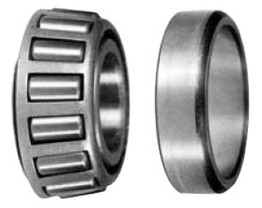
 thebigbearingstore.com
thebigbearingstore.com
If you decide you need to (or just want to) replace your track belts, I would highly encourage you to buy the belting and punch them yourself. We did that and I wrote a pretty thorough thread on the process. You can save a chunk of money this way.
I remember a phone call with Tucker's Parts Department that was I suppose 15 years ago. They quoted a number of prices for me and obviously with 15 years of inflation one would expect current prices to be higher. However, in my experience Tucker's prices have increased appreciably more than the rate of inflation would suggest.
I THINK back then one new spindle was very close to $100. My guess is the new design spindles are likely north of twice that. And you probably need different castle nuts, as well as the caps.
It's easy, actually very easy, to spend some pretty serious money on parts from Tucker. I don't doubt for a minute the new spindle design is better, but if your spindles are in good shape it's hard to justify that expense, at least it is for me. If I still was thinking about it, I would take one of the new ones to a local machine shop and see what they would charge to make a set for you.
This may seem wasteful, but I stopped cleaning and inspecting the idler wheel bearings. You'd take the time to clean the bearing thoroughly, and then when inspecting it you'd find some pitting on the rollers. Then you scrap the bearing and you've just wasted that time. The carriers on the Thundercat and CHUGSzilla projects are 1600 series, and they have damper wheels, so a total of 72 bearings per machine.
The last time I bought those bearings (yes, made in China) a bearing set; meaning tapered roller bearing and race were around $4.00. Yes, prices are now higher thanks to Bidenomics, but here's a link:

LM67048/LM67010 Tapered Cup and Cone Set
Find all the bearings, bearing housings, v-belts, oil seals, collars you need and more including the LM67048/LM67010 Tapered Cup and Cone Set at theBigBearingStore.com
 thebigbearingstore.com
thebigbearingstore.com
If you decide you need to (or just want to) replace your track belts, I would highly encourage you to buy the belting and punch them yourself. We did that and I wrote a pretty thorough thread on the process. You can save a chunk of money this way.
BFT,
Thanks again for the info, I wound up finding bearings at Rock Auto and they ranged from $8.22 to $6.41 per bearing and seals were $1.46 ea. so can do one wheel for around $18 depending on the bearings you choose, have not reached out to Tucker for the other seals but will today and will let everyone know.
Thanks again for the info, I wound up finding bearings at Rock Auto and they ranged from $8.22 to $6.41 per bearing and seals were $1.46 ea. so can do one wheel for around $18 depending on the bearings you choose, have not reached out to Tucker for the other seals but will today and will let everyone know.
I will get some pictures of mine today and post them, I do believe that it will be cheaper to just have them machined at local shop but once I get them out and get some pricing will let everyone know on that as well, well at least machining costs here in SE Wyo. Really wish I had a lathe it would be much easier.
So the first picture is up close of what I am assuming is the new spindle (TA and BFT please correct if I am wrong). The next 2 pictures are of old spindle I did not get pictures of the spacers but I do have both old and new spacers (without and with o-ring groove) you can also see the difference in the castle nuts the old spindles have quite a bit heavier nut on them. All of my new spindles have the press fit caps on them, have a mix on the back tracks as well with and without caps. Depending on cost and if I can get them out without tearing them up I plan on going with the new style and running caps on all (might be a little OCD on things like that) but all depends on cost.
Hope everyone has a happy St. Patrick’s Day
Hope everyone has a happy St. Patrick’s Day
Attachments
Track Addict
Bronze Member
That’s the new and old. One old looks to have a crusty race frozen on.
Save the money and spend that time and money on more greasing. If you grease after every use bet the bearings last for ever.
It’s when they sit with moisture the trouble starts. Front and year idlers are the ones that will disable the machine for a failure. You can at least limp on the middles.
Focus on those if your super concerned to start.
Save the money and spend that time and money on more greasing. If you grease after every use bet the bearings last for ever.
It’s when they sit with moisture the trouble starts. Front and year idlers are the ones that will disable the machine for a failure. You can at least limp on the middles.
Focus on those if your super concerned to start.
Track Addict
Bronze Member
My 1443 thread should cover a bunch of this from Feb 2024 on including re tubing and new journals on the rear axle!
TA,
Parts should be in this week so hopefully can start getting everything put back together, but going to have to wait a week we are headed up to cabin in North West Wyoming for a week of snowmobiling then headed over to the RMSHA hill climbs in Jackson for the weekend, if you have never been they are a blast to watch and Jackson is a tough hill. I will have plenty to get back to and then after graduation party concentrate on removing spindles and replacing then ones that are pretty chewed up and putting anti seize on all of them. I have been chipping away on your 1443 thread and tons of great info in there seriously appreciate sharing all of the info.
Parts should be in this week so hopefully can start getting everything put back together, but going to have to wait a week we are headed up to cabin in North West Wyoming for a week of snowmobiling then headed over to the RMSHA hill climbs in Jackson for the weekend, if you have never been they are a blast to watch and Jackson is a tough hill. I will have plenty to get back to and then after graduation party concentrate on removing spindles and replacing then ones that are pretty chewed up and putting anti seize on all of them. I have been chipping away on your 1443 thread and tons of great info in there seriously appreciate sharing all of the info.
Ill throw $.02 in here as most every thing is covered expertly.
1) bearing loading. On flat snow i agree 100% on loading. However, some food fir thought. I/we operate on some less than ideal surfaces, snowless access roads, frozen lakes agricultural lands, forested lands. A chunk of ice, dirt clod or stick puts the corner weight of the machine onto the bearing(s) and if your scooting along factor some shick loading in for fun.
2) any one of the greases you listed will be fine. One of the two complex formulas will have a water rating. I was enlightened in a mining area by a distributor who took great interest in my kitten inside of a school bus. (That fuel stop took 1.5 hrs)
3) pounding. If you have access to a metal lathe. Make or have someone make a tool to thread onto the nut or wheel side. We have found the driving them in is much more successful than driving them out. ( beer infused ) concensus is the axles are expanding and like a rivet getting tighter. With a tool or block of wood going the other way is better. If you do happen to deform it. You tap it back. Cut it off and it usually pushes out. (We have drilled a few out) drilling is work, but its predictable. And thats good for mental stability.
4) we have found that the capped axles are just (the width of the spacer) shorter. Find a lathe shorten your axles. Or buy taller caps. I found tall caps at e trailer. They look goofy, but i cant see them from the drivers seat. And they are full of snow when im greasing them....
Btw. Welcome to grooming machines. Volunteer run, non profit snow mobile clubs can do anything with nothing. And sometimes they do nothing with everything.
1) bearing loading. On flat snow i agree 100% on loading. However, some food fir thought. I/we operate on some less than ideal surfaces, snowless access roads, frozen lakes agricultural lands, forested lands. A chunk of ice, dirt clod or stick puts the corner weight of the machine onto the bearing(s) and if your scooting along factor some shick loading in for fun.
2) any one of the greases you listed will be fine. One of the two complex formulas will have a water rating. I was enlightened in a mining area by a distributor who took great interest in my kitten inside of a school bus. (That fuel stop took 1.5 hrs)
3) pounding. If you have access to a metal lathe. Make or have someone make a tool to thread onto the nut or wheel side. We have found the driving them in is much more successful than driving them out. ( beer infused ) concensus is the axles are expanding and like a rivet getting tighter. With a tool or block of wood going the other way is better. If you do happen to deform it. You tap it back. Cut it off and it usually pushes out. (We have drilled a few out) drilling is work, but its predictable. And thats good for mental stability.
4) we have found that the capped axles are just (the width of the spacer) shorter. Find a lathe shorten your axles. Or buy taller caps. I found tall caps at e trailer. They look goofy, but i cant see them from the drivers seat. And they are full of snow when im greasing them....
Btw. Welcome to grooming machines. Volunteer run, non profit snow mobile clubs can do anything with nothing. And sometimes they do nothing with everything.
Can you share part numbers or links?BFT,
Thanks again for the info, I wound up finding bearings at Rock Auto and they ranged from $8.22 to $6.41 per bearing and seals were $1.46 ea. so can do one wheel for around $18 depending on the bearings you choose, have not reached out to Tucker for the other seals but will today and will let everyone know.
Track Addict
Bronze Member
Cruise this page 38 of my thread. A6 Bearings and skf seal part number in one of the pics.
Cross to what you can get. Time and ebay can save amazon as well.
Cross to what you can get. Time and ebay can save amazon as well.
Page 38 of what thread?Cruise this page 38 of my thread. A6 Bearings and skf seal part number in one of the pics.
Cross to what you can get. Time and ebay can save amazon as well.
Track Addict
Bronze Member
1443 new to me.
I posted a link in post 38. That's where I have purchased bearings before. The bearings were well packaged and the shipping cost was surprisingly reasonable, as I remember.Can you share part numbers or links?
@Blackfoot Tucker Thank you! You are always very thorough!


